
Editor’s Note: Today brings the first step in our bartsketball project, as Clint Peterson takes a look at the physical side of art in basketball, through sculpture. You may also like to read an introduction to the bartsketball project.
One of the biggest honors bestowed upon NBA greats is being immortalized in bronze for fans. Many of these statues have become destinations to themselves. In Salt Lake City, Utah, on John Stockton Drive, running right past the front doors of the Energy Solutions Arena, home of the Utah Jazz, are a pair of larger-than-life statues of two of the NBA’s 50 Greatest Players: Karl Malone and John Stockton. One-and-a-half times life-sized, to be precise. Commissioned by Larry H. Miller, the late owner of the Jazz, in 2003, to commemorate Stockton’s accomplishments in NBA was Sandy, Utah resident Brian Challis.
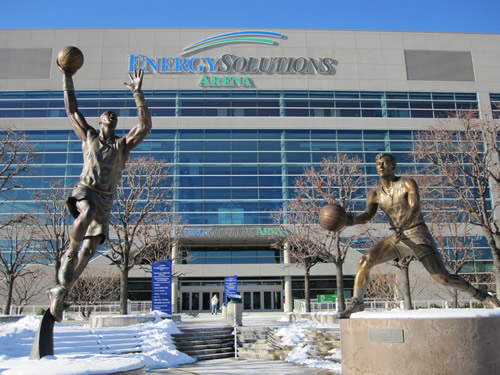
Challis isn’t the only local tie to sculpting sports greats, however. Just south around the hill, where Interstate 15 bends around the Wasatch Front, headed into BYU Cougar country (known locally as “the point of the mountain”), tucked up against the hills, is a town that appears to be plucked straight out of the Swiss Alps, Highland, Utah.
Current Highland resident Blair Buswell, who grew up in Ogden, an hour north of Salt Lake City, has had the honor of bronzing more than 70 of the Pro Football Hall of Fame’s more than 250 members’ busts, including former BYU teammate and HOFer Steve Young, as well as Joe Montana, and John Madden. He is the chief sculptor for the Pro Football Hall of Fame, and the creator of the AFC and NFC Championship winner trophies.
The acclaimed Mr. Buswell has also crafted such major sports awards trophies as the Doak Walker Award for college football’s best running back, Major League Baseball’s Home Run Champion, and many more, while also honoring such legends of sport as baseball’s Mickey Mantle and golf’s Jack Nicklaus with bigger-than-life timeless monuments.
It’s a good thing he kept his day job, or else we wouldn’t have the pleasure of gazing another basketball immortal, Oscar “Big O” Robertson. Buswell crafted this beauty for the University of Cincinnati. You can see more of the raw work in progress here.

Mr. Buswell is currently in the finishing stages of his latest work, the recently deceased Fearsome Foursome NFL great Merlin Olsen, for Mr. Olsen’s alma mater, Logan, Utah’s University of Utah. I’ll have an exclusive inside peek of this amazing process for you in the coming days. You don’t want to miss it!
Creating such outstanding works of art takes literally months of near round-the-clock attention to detail. Producing masterful metal must require some sort of patience and a mentality that few possess, and more cups of coffee than I can possibly imagine. At the unveiling of the Stockton statue, the late Mr. Miller informed those in attendance of the type of commitment it takes to complete just such a monumental task, by telling them that Mr. Challis “First sculpted the dots on a basketball, and he counted them. This sounds like a phony number, he swears it’s true but I’m not going to count them to verify. But the dots on that basketball number 44,444, and you have to question the mentality to count those. To sculpt them is one thing, counting is another.”
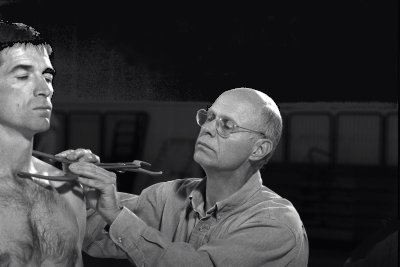
When something will be out there for centuries, for all to see, the devil most assuredly is in the details. How Mr. Challis got an entire bronze built in a mere eight months is beyond my capacity to imagine. I’d be lucky to have successfully counted 44,444 dots in that same span of time.
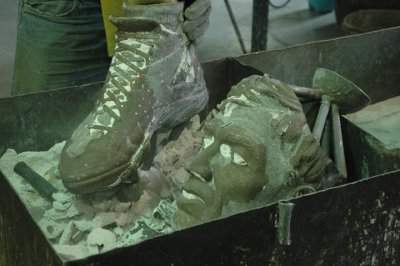
Challis began fulfilling the other half of the bargain without even ever having met the man. He had done much of the work on the Malone bronze, that would shortly join John on the steps of the ESA (then the Delta Center), using only an artists’ eye and the basic information that the rest of us mortals have access to.
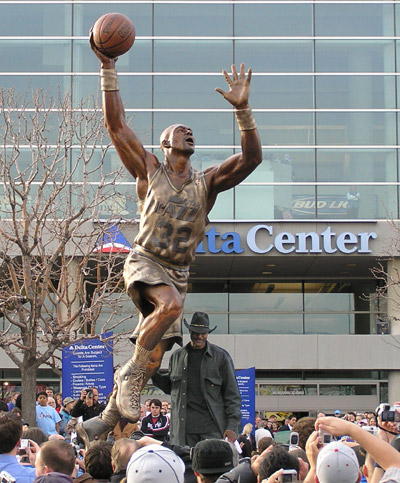
He pressed on as Malone made his final run sans Stockton, with the Los Angeles Lakers, simply stating, “There are still things he [Malone] could help me with. I’d like to measure the girth of his leg when he lifts it up. And his chest. I hope when the season is over we can get together. I don’t need to, but I’d like to. You always get a better piece of sculpture that way.”
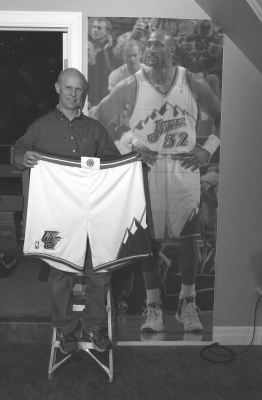
Oft times mentioned as “a 3-D M.C. Escher,” more of Brian Challis’ work can be seen here.
Every time I drive down SLC’s 300 West, where it turns into John Stockton Drive, I find my eyes drawn to the giants that were such a huge part of my upbringing that keep watch over downtown Salt Lake, forever balling on the front walk of the ESA. Over the years I wondered many times if maybe Karl and John liked them as much as I do. I’d never dream of doing what a group of youngsters did last January; climb all over Stock’s statue…
Local Jazz beat writer for the Deseret News, Jody Genessy, was headed out of the arena some three months back when this peculiar incident was witnessed on the walk:
An unexpected incident such as this from a man as close to shy and reclusive as it gets in The Association’s annals of history might warrant something along these lines, wouldn’t you say?
This is Part One of an exclusive three-part series that Clint Peterson will be writing for bartsketball. You can follow him on twitter. Look out for Parts Two and Three over the coming weeks. You are encouraged to get involved with the project — read the introduction to the bartsketball project and share the inspiration.
